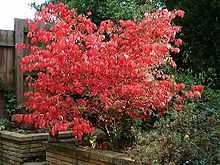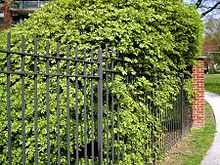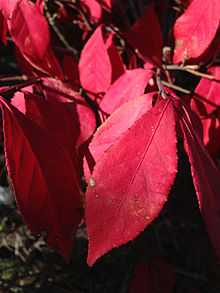Euonymus alatus
| Euonymus alatus | |
|---|---|
 | |
| Scientific classification | |
| Kingdom: | Plantae |
| (unranked): | Angiosperms |
| (unranked): | Eudicots |
| (unranked): | Rosids |
| Order: | Celastrales |
| Family: | Celastraceae |
| Genus: | Euonymus |
| Species: | E. alatus |
| Binomial name | |
| Euonymus alatus (Thunb.) Siebold | |
Euonymus alatus, known variously as winged spindle, winged euonymus or burning bush, is a species of flowering plant in the family Celastraceae, native to central and northern China, Japan, and Korea.
This deciduous shrub grows to 2.5 metres (8 ft 2 in) tall, often wider than tall. The stems are notable for their four corky ridges or "wings". The word alatus (or alata, used formerly) is Latin for "winged", in reference to the winged branches. These unique structures develop from a cork cambium deposited in longitudinal grooves in the twigs' first year, unlike similar wings in other plants.[1] The leaves are 2–7 centimetres (0.79–2.76 in) long and 1–4 centimetres (0.39–1.57 in) broad, ovate-elliptic, with an acute apex. The flowers are greenish, borne over a long period in the spring. The fruit is a red aril enclosed by a four-lobed pink, yellow or orange capsule.
The common name "burning bush" comes from the bright red fall color.
It is a popular ornamental plant in gardens and parks due to its bright pink or orange fruit and attractive fall color. The species[2] and the cultivar 'Compactus'[3] have both gained the Royal Horticultural Society's Award of Garden Merit.
This plant is an invasive species of woodlands in eastern North America,[4] and its importation and sale is prohibited in the states of Massachusetts[5] and New Hampshire.[6]


E. alatus is used in traditional Chinese medicine to promote blood stasis to promote menstruation, remove toxic materials, subside swelling, and kill insects or parasites.[7]
References
- ↑ Bowen, R. A. (1963). "Botanical Gazette". 124 (4). pp. 256–261.
- ↑ "Euonymus alatus". RHS Plant Selector Euonymus alatus AGM / RHS Gardening. Apps.rhs.org.uk. Retrieved January 11, 2013.
- ↑ "Euonymus alatus 'Compactus' AGM". RHS Plant Selector Euonymus alatus 'Compactus' AGM / RHS Gardening. Apps.rhs.org.uk. Retrieved January 11, 2013.
- ↑ Swearingen, J. et al. (2002). "Winged Burning Bush". Plant Invaders of Mid-Atlantic Natural Areas. National Park Service and U.S. Fish & Wildlife Service.
- ↑ Massachusetts Prohibited Plant List. Massachusetts Department of Agricultural Resources. Retrieved 4 July 2013.
- ↑ Prohibited Plants. New Hampshire Department of Agriculture, Markets and Food. Retrieved 4 July 2013.
- ↑ Wang L, Waltenberger B, Pferschy-Wenzig EM, Blunder M, Liu X, Malainer C, Blazevic T, Schwaiger S, Rollinger JM, Heiss EH, Schuster D, Kopp B, Bauer R, Stuppner H, Dirsch VM, Atanasov AG. Natural product agonists of peroxisome proliferator-activated receptor gamma (PPARγ): a review. Biochem Pharmacol. 2014 Jul 29. pii: S0006-2952(14)00424-9. doi: 10.1016/j.bcp.2014.07.018. PubMed PMID 25083916.
Further reading
- Rhoads, A. F. and T. A. Block (2000). The Plants of Pennsylvania. University of Pennsylvania Press. ISBN 0-8122-3535-5.
| Wikimedia Commons has media related to Euonymus alatus. |